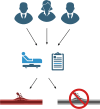Predictors of bleeding complications during catHeter-dirEcted thrombolysis for peripheral arterial occlusions (POCHET)
- PMID: 38722842
- PMCID: PMC11081216
- DOI: 10.1371/journal.pone.0302830
Predictors of bleeding complications during catHeter-dirEcted thrombolysis for peripheral arterial occlusions (POCHET)
Abstract
Introduction: The risk of major bleeding complications in catheter directed thrombolysis (CDT) for acute limb ischemia (ALI) remains high, with reported major bleeding complication rates in up to 1 in every 10 treated patients. Fibrinogen was the only predictive marker used for bleeding complications in CDT, despite the lack of high quality evidence to support this. Therefore, recent international guidelines recommend against the use of fibrinogen during CDT. However, no alternative biomarkers exist to effectively predict CDT-related bleeding complications. The aim of the POCHET biobank is to prospectively assess the rate and etiology of bleeding complications during CDT and to provide a biobank of blood samples to investigate potential novel biomarkers to predict bleeding complications during CDT.
Methods: The POCHET biobank is a multicentre prospective biobank. After informed consent, all consecutive patients with lower extremity ALI eligible for CDT are included. All patients are treated according to a predefined standard operating procedure which is aligned in all participating centres. Baseline and follow-up data are collected. Prior to CDT and subsequently every six hours, venous blood samples are obtained and stored in the biobank for future analyses. The primary outcome is the occurrence of non-access related major bleeding complications, which is assessed by an independent adjudication committee. Secondary outcomes are non-major bleeding complications and other CDT related complications. Proposed biomarkers to be investigated include fibrinogen, to end the debate on its usefulness, anti-plasmin and D-Dimer.
Discussion and conclusion: The POCHET biobank provides contemporary data and outcomes of patients during CDT for ALI, coupled with their blood samples taken prior and during CDT. Thereby, the POCHET biobank is a real world monitor on biomarkers during CDT, supporting a broad spectrum of future research for the identification of patients at high risk for bleeding complications during CDT and to identify new biomarkers to enhance safety in CDT treatment.
Copyright: © 2024 Mol et al. This is an open access article distributed under the terms of the Creative Commons Attribution License, which permits unrestricted use, distribution, and reproduction in any medium, provided the original author and source are credited.
Conflict of interest statement
The authors have declared that no competing interests exist.
Figures
References
-
- Björck M, Earnshaw JJ, Acosta S, Gonçalves FB, Cochennec F, Debus SE, et al.. Editor’s Choice–European Society for Vascular Surgery (ESVS) 2020 Clinical Practice Guidelines on the Management of Acute Limb Ischaemia. European Journal of Vascular and Endovascular Surgery. 2020. Feb 1;59(2):173–218. doi: 10.1016/j.ejvs.2019.09.006 - DOI - PubMed
-
- Ebben HP, Jongkind V, Wisselink W, Hoksbergen AWJ, Yeung KK. Catheter Directed Thrombolysis Protocols for Peripheral Arterial Occlusions: a Systematic Review. Vol. 57, European Journal of Vascular and Endovascular Surgery. W.B. Saunders Ltd; 2019. p. 667–75. - PubMed
-
- Leenstra BS, van Ginkel DJ, Hazenberg CEVB, Vonken EJPA, de Borst GJ. Heterogeneity in Standard Operating Procedures for Catheter Directed Thrombolysis for Peripheral Arterial Occlusions in The Netherlands: A Nationwide Overview. European Journal of Vascular and Endovascular Surgery [Internet]. 2019;58(4):564–9. Available from: 10.1016/j.ejvs.2019.02.028. - DOI - PubMed
Publication types
MeSH terms
Substances
LinkOut - more resources
Full Text Sources
Medical





